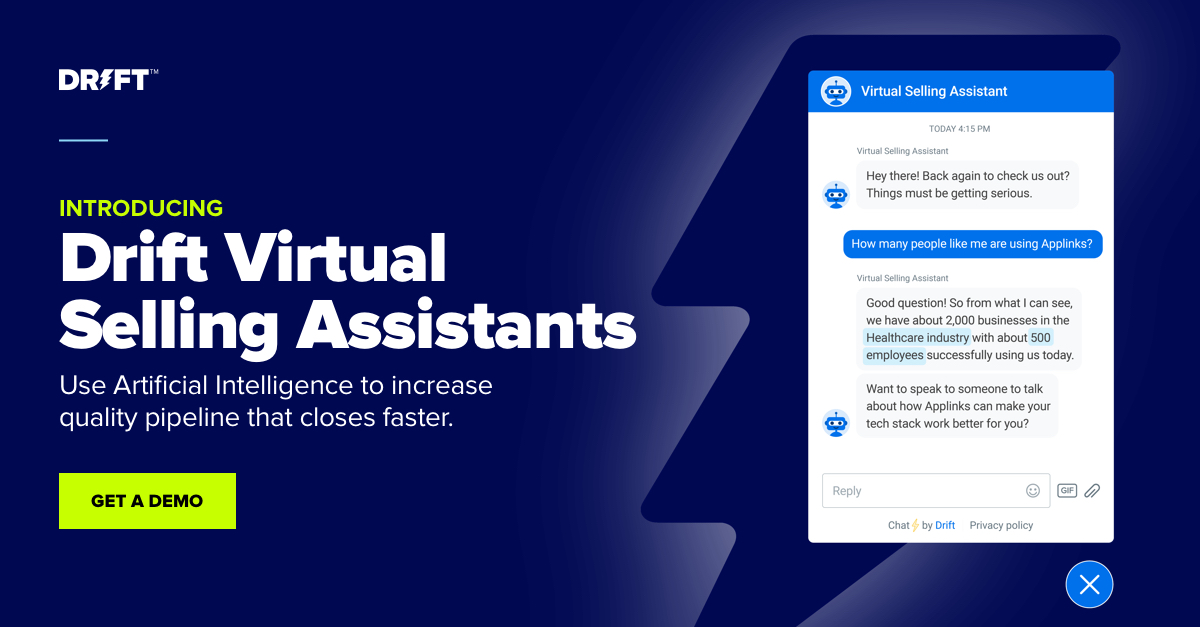Those of us old enough to remember visiting Blockbuster on a Friday night knew to never rent a “straight to video” movie. Back in the day when you heard a movie was “straight to video,” you automatically knew it wasn’t going to be good. In fact, it was almost guaranteed to be a flop that never saw the light of day.
In sales, the same is true for salespeople with a “straight to demo” customer outreach approach. It’s cold, it’s not personalized, and it reeks of snake oil salesmanship. Not exactly what you want your company to be associated with.
For years, the traditional sales process has been to set up demos, make a profit, rinse, and repeat. However, since consumers have become more sophisticated in how they receive sales information, it’s become tougher for salespeople to successfully repeat this old school process.
Here’s where Sales Development Representatives (SDRs) come into play. Rather than have Account Executives (AEs) with pages of phone numbers to cold call, sales as a process has evolved itself. SDRs begin the sales process by analyzing a set of companies and determine which customers are more likely to buy your product or service. From there, they build relationships, investigate paint points, pique their interest, and generate opportunities for AEs to close.
Although SDRs are considered an entry-level role, they’re actually one of the most critical parts of a company’s sales team. Sure, AEs are usually what people think of when it comes to sales. But SDRs work hard to qualify which leads are worth pursuing and which should be left alone. And don’t forget – with a successful internal career path, SDRs can become the future AEs of your company.
When growing your company, SDRs are one of the most integral parts of a successful upward sales trajectory. Recently, I spoke with research and advisory firm TOPO’s Senior Sales Practice Analyst, Dan Gottlieb, about the ways SDRs can increase their productivity and ultimately boost sales. Here’s a rundown of what we covered and how you can apply it to your sales org.
If you want to watch our presentation, click here. Otherwise, keep reading for all the insights 💡
How Are SDRs Improving the Sales Development Ecosystem?
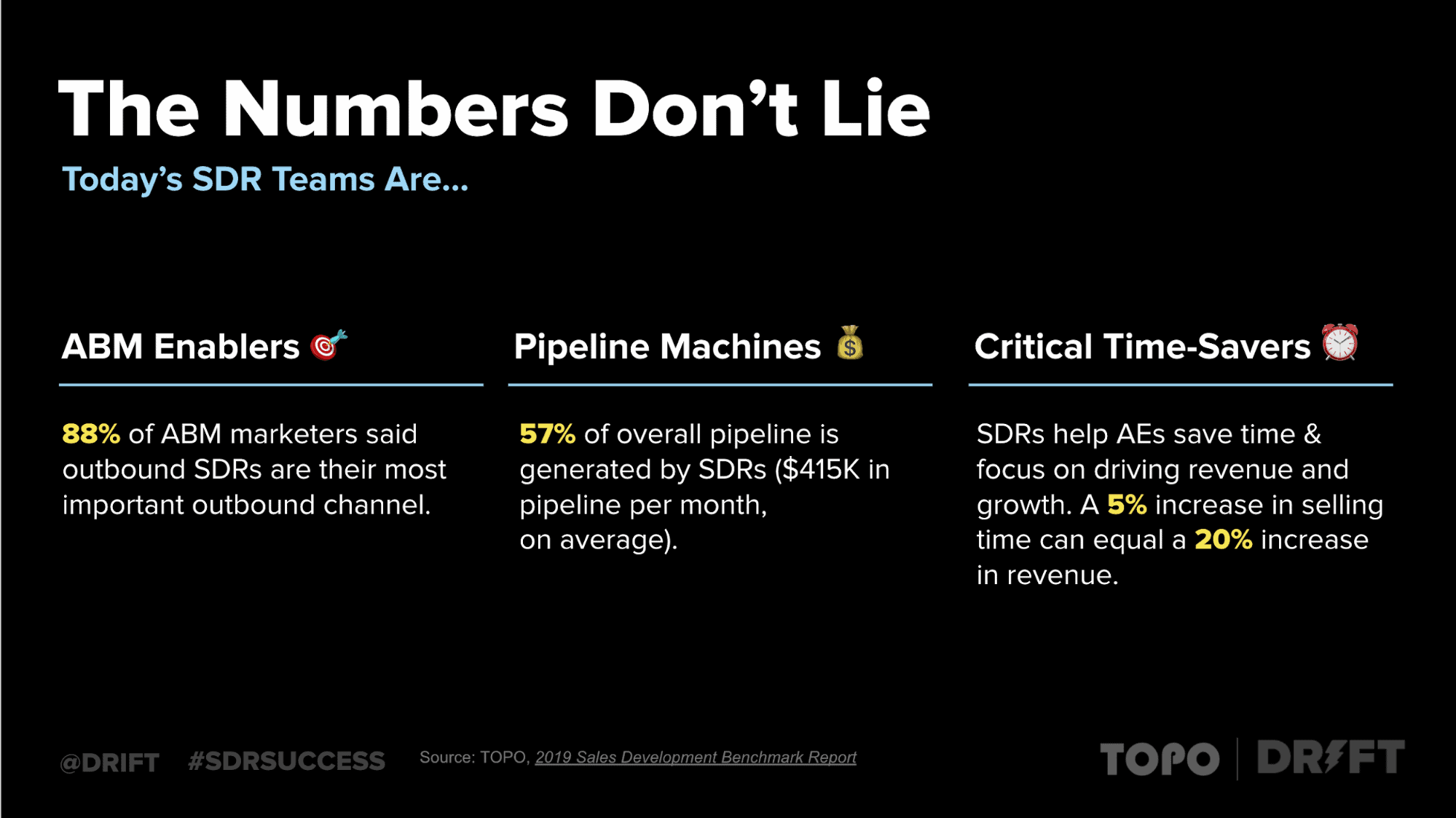
Last year at Drift, we hired four SDRs for the first time to see how it could improve our sales processes. In just one year, we were able to have this group generate 80% of the entire enterprise revenue pipeline.
After we set SDRs in motion, here’s what happened:
- AEs had more time to focus on selling
- SDRs specialized in prospecting
- People looking to get into the game had an entry-level path to understand how the sales process works
Even though the numbers above look great, according to TOPO’s 2019 Sales Development Benchmark Report, only 48% of SDRs hit their quotas in 2019. Yes – like any other profession, this one doesn’t come without some challenges. With the number of accounts and intricacies that face these early-career (but extremely important) external-facing employees, there are obstacles to overcome.
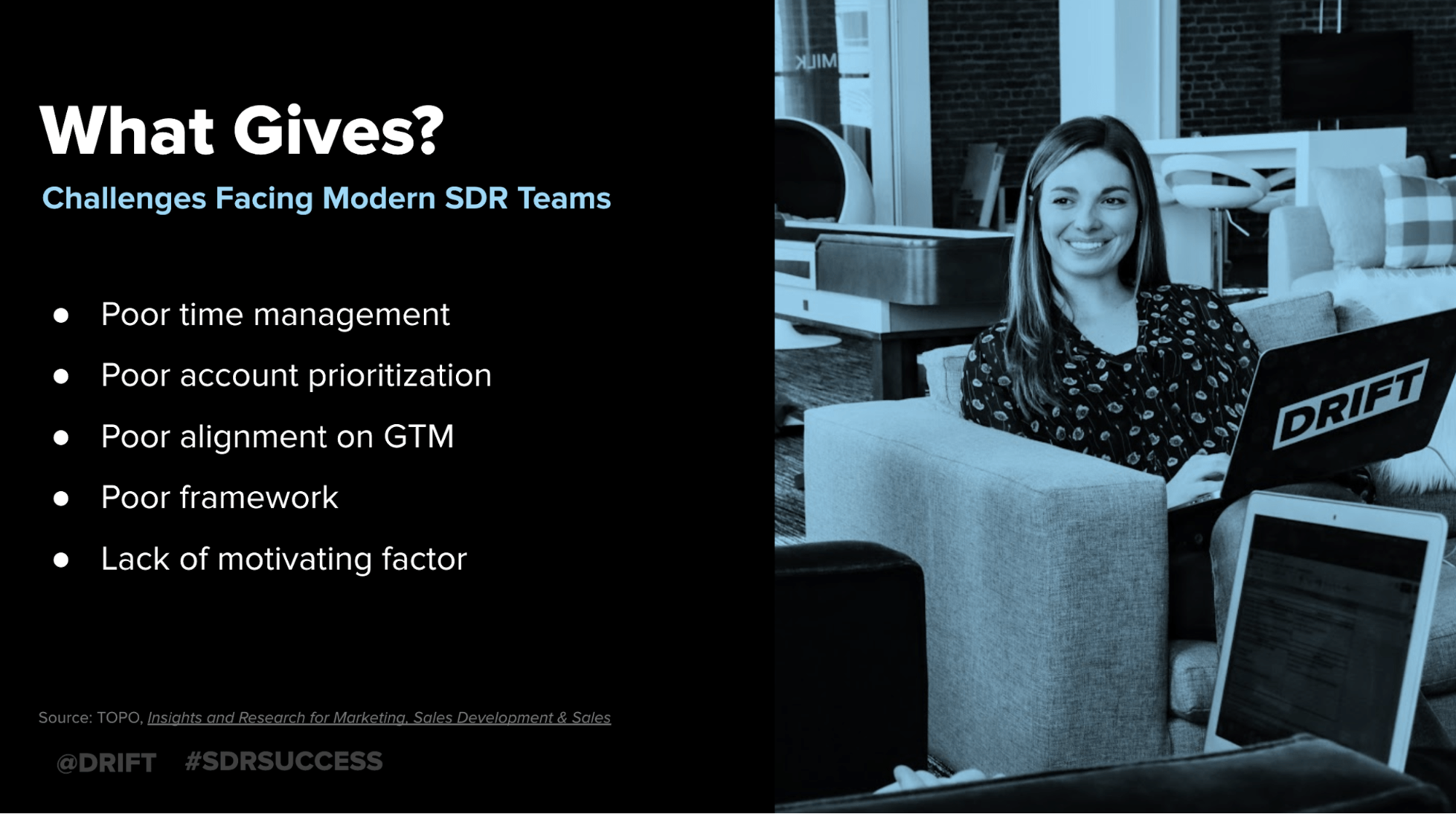
The challenges listed above are real. But they also have real solutions. Let’s dig in.
How to Prioritize Accounts
To ensure SDRs are successful, support from AEs is crucial. SDRs also must find the time to learn how to prioritize accounts so they can increase performance on hitting their quotas.
SDRs have become a strategic part of the pipeline to help support the business. To help SDRs be more successful in hitting their quotas, with or without extra help, the three areas they must focus on include segmentation, engagement, and intent.
Segmentation
SDRs can get upwards of 500 accounts to focus on. But it goes without saying – not all accounts should be treated equally.
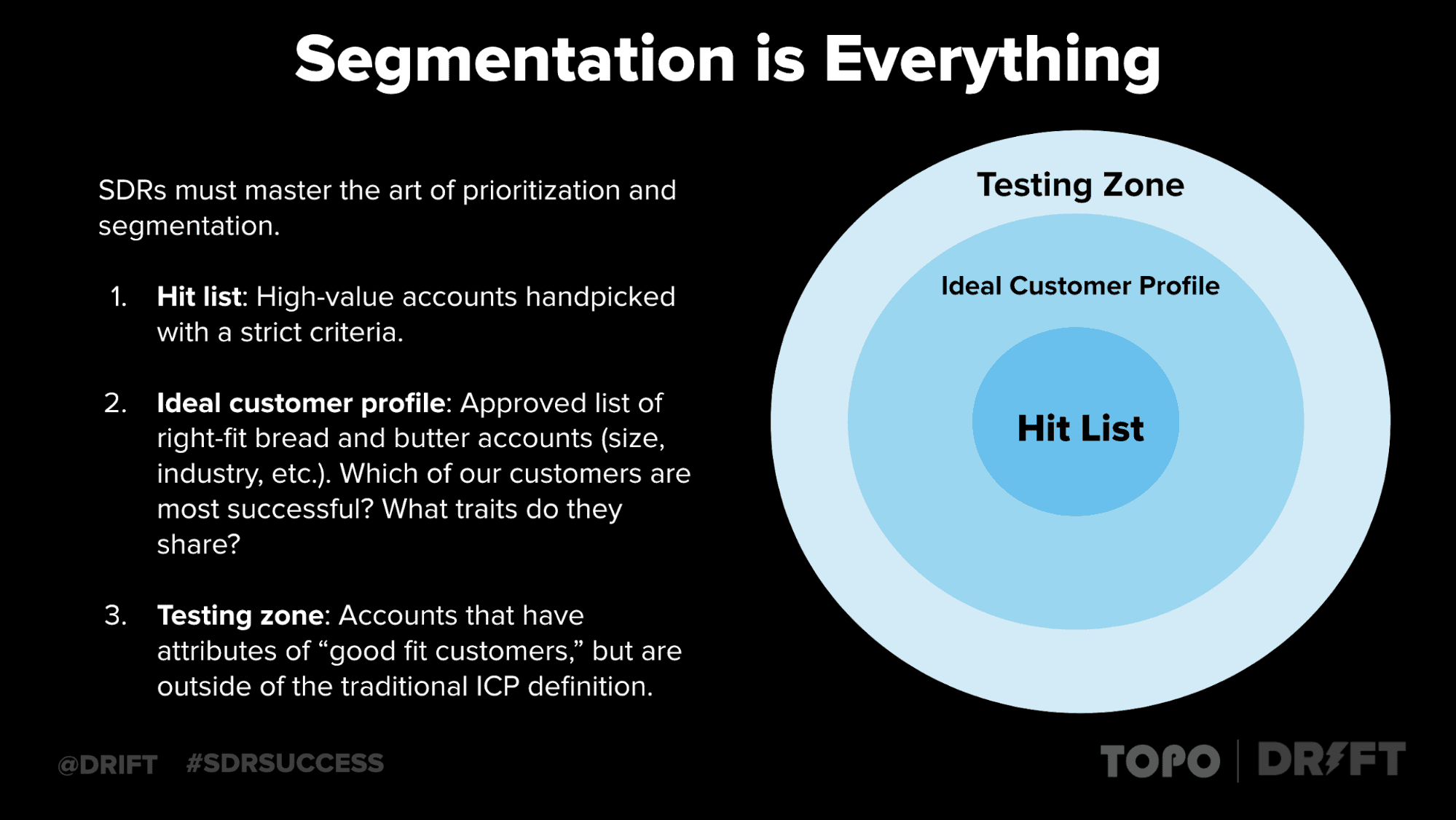
In this first part of the SDR lead qualifying process, customers should be split into groups ranging from most likely to buy and least likely to buy. This is known as the “hit list.” Depending on the SDR and company size, this process may vary.
After dividing prospective buyers into industry segments, they are then put into company size including large, medium, and small for the ideal customer profile. Within each of those groups, the SDR breaks it down into smaller, more manageable pieces.
After this is complete, SDRs can dip their toes into the “testing zone” of customers outside the usual ICP definition and then move onto the engagement process.
Engagement
At Drift, we’re all about meeting people where they are. In the SDR engagement process, this is an area to learn the ways companies prefer to give and receive communication.
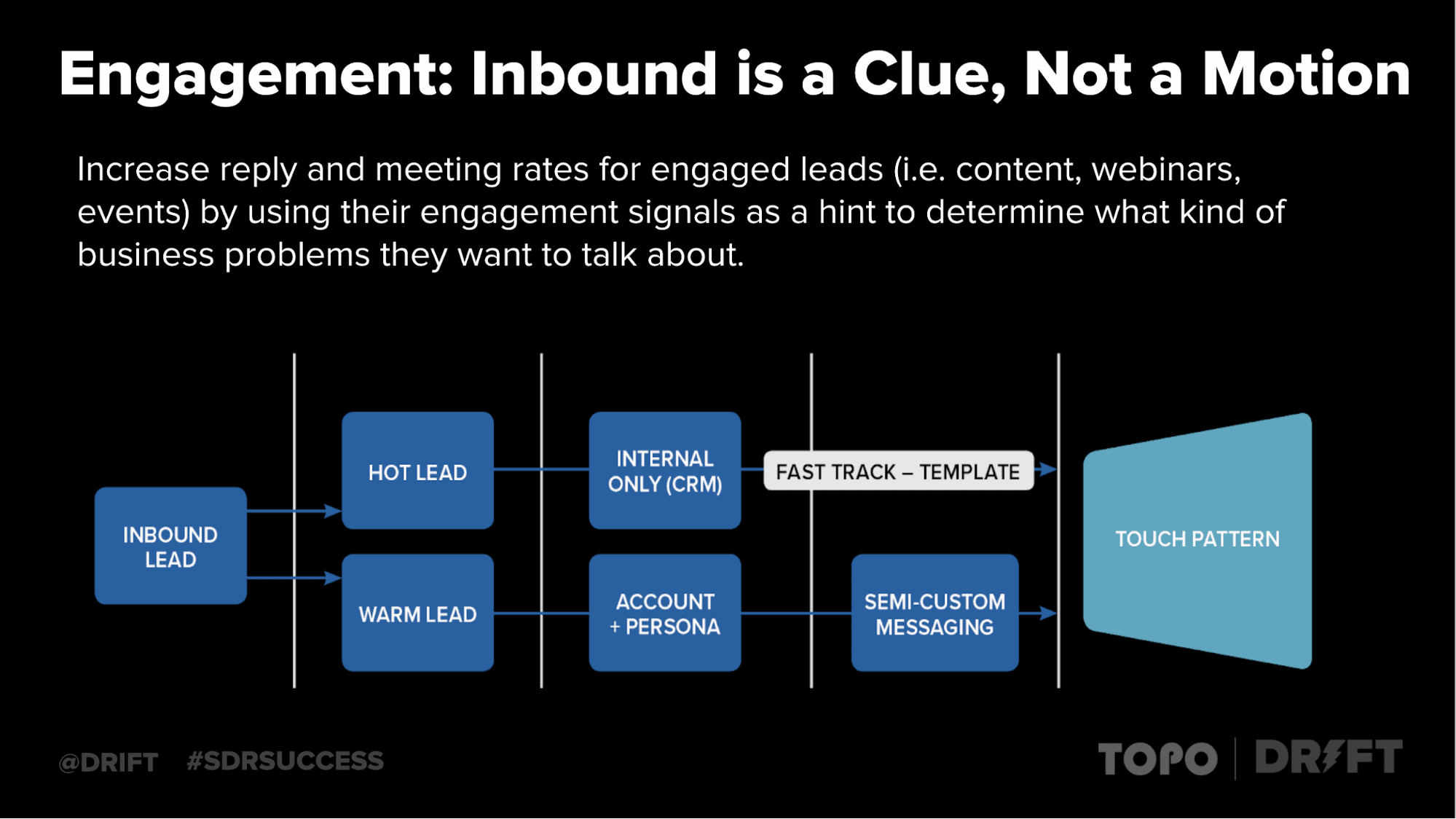
While it may have been all about cold calling in the past, today you’re more likely to receive a warm response sending an email first. No, it’s not impersonal to send an email first over calling.
When you choose to send an email first, it gives prospective customers time to read up on your company and what it’s offering before talking with you. In a sense, it warms up the prospect before the SDR follows up with a phone call to dive into further details. An added bonus is you’re giving prospects the option to engage on their own time.
And one more thing – use this as an opportunity to build some familiarity. That way, even if the prospect doesn’t remember your company or your name in their email inbox – if you surround them on email, social, and then calls, they will start to recognize your name and appreciate your professional persistence.
Intent
It’s not enough to segment customers into groups and engage at the right time, you also have to have the right message for the right person. This is where intent data comes into play.

More and more, companies are using intent data to ensure the interested parties are spoken to in a particular manner. It’s easy to skip over messages addressed to “Dear Sir or Madam” and don’t serve any specific purpose for them.
Prospective customers don’t want to be inundated with messages that aren’t relevant to them. By implementing these simple organizational tactics, SDRs are better prepared to succeed in their efforts.
Building & Scaling a Highly-Productive SDR Team
But here’s the thing. It’s not enough to only have SDRs prepared, sales development leaders must also be well equipped to build and scale a productive team. This can be accomplished by teaching time management, re-engagement, metrics, and motivation.
Time Management
It goes without saying but managing time effectively throughout a workday is one of the harder parts of a job. It’s easy to get sucked into a side conversation with co-workers or spend too much time on a few tasks. I’m guilty of it too – you look up at the clock, it’s 4PM, and you wonder where the day went (this is especially true now that we’re working from home).
As Dan says: “The X factor for salespeople has always been time management, but it’s getting more sophisticated. So, what we realized is that time management is about having a realistic and data-driven approach in order to think about your time.”
It’s so simple that we don’t talk about it, but one of the biggest challenges SDRs have is how to spend their time and where to spend their time.
To help SDRs, (who, remember are still pretty entry-level), teaching time management is part of the sales leadership package. Here are a few ways Dan says you can to do this:
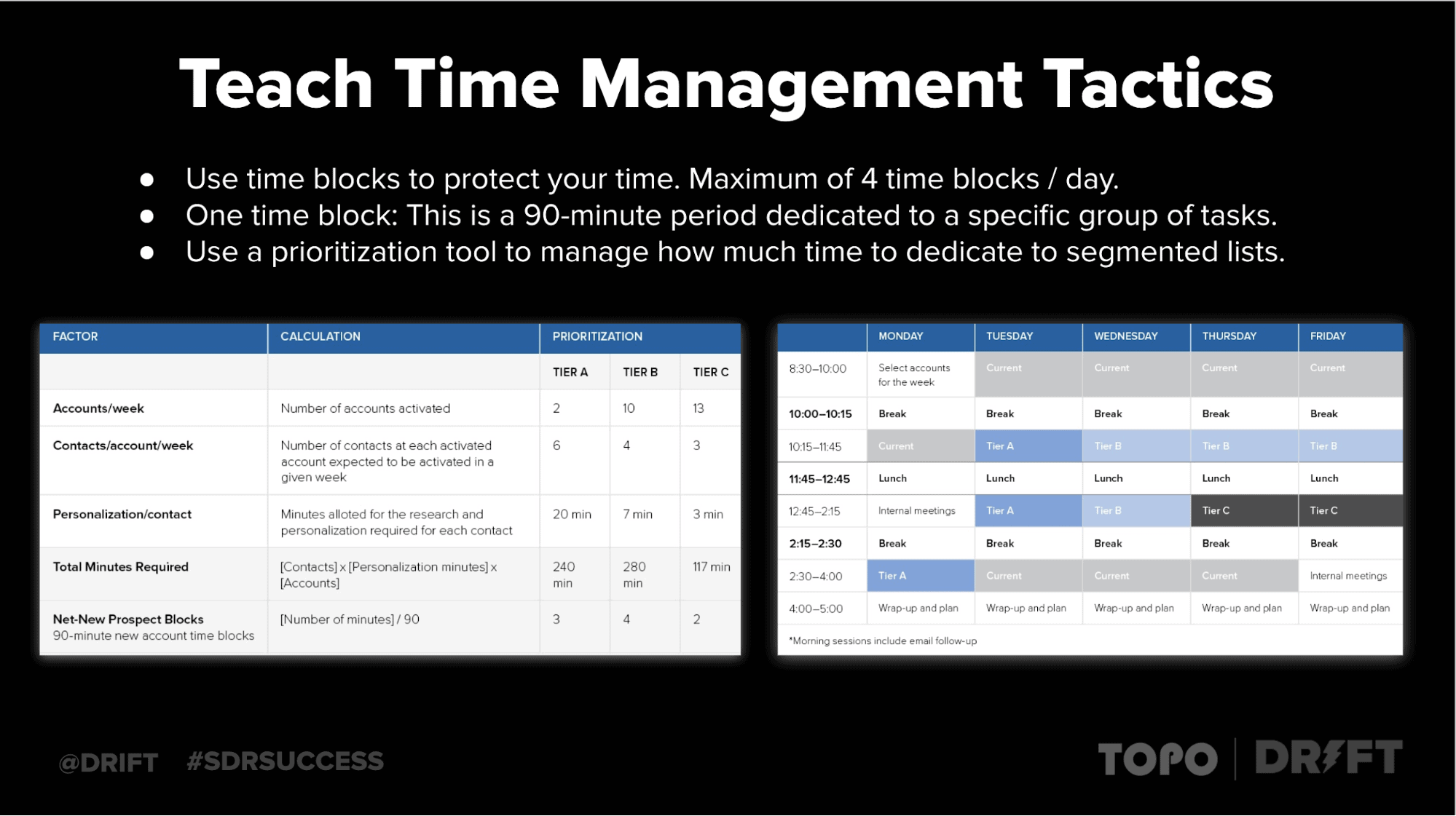
Again, these are super simple concepts. But being thoughtful about your day by using some combination of time blocks, timers, and prioritization tools can make all the difference.
Re-engagement
Sales is a game of patience and persistence. Not everyone responds to the first or second interaction with an SDR. Instead, it can take between 17-22 touches, according to 6sense. Those that understand this will more often than not find themselves to be outperforming their colleagues.
Dan says: “What we’re finding when you look at what the best SDRs are doing, is a significant number of the meetings and opportunities they’re booking aren’t just coming from these initial waves. They’re coming from this steady stream of people that engage with them. They start a conversation but the customer is not quite ready yet. The SDRs slowly nurture these relationships and come back to when the timing is right. Those are actually the SDRs that are the most consistent and high performing.”
Each time an SDR connects with a customer, we call this a Re-engagement Touch Pattern. We can analyze each interaction to determine if there’s a preferred outreach pattern.
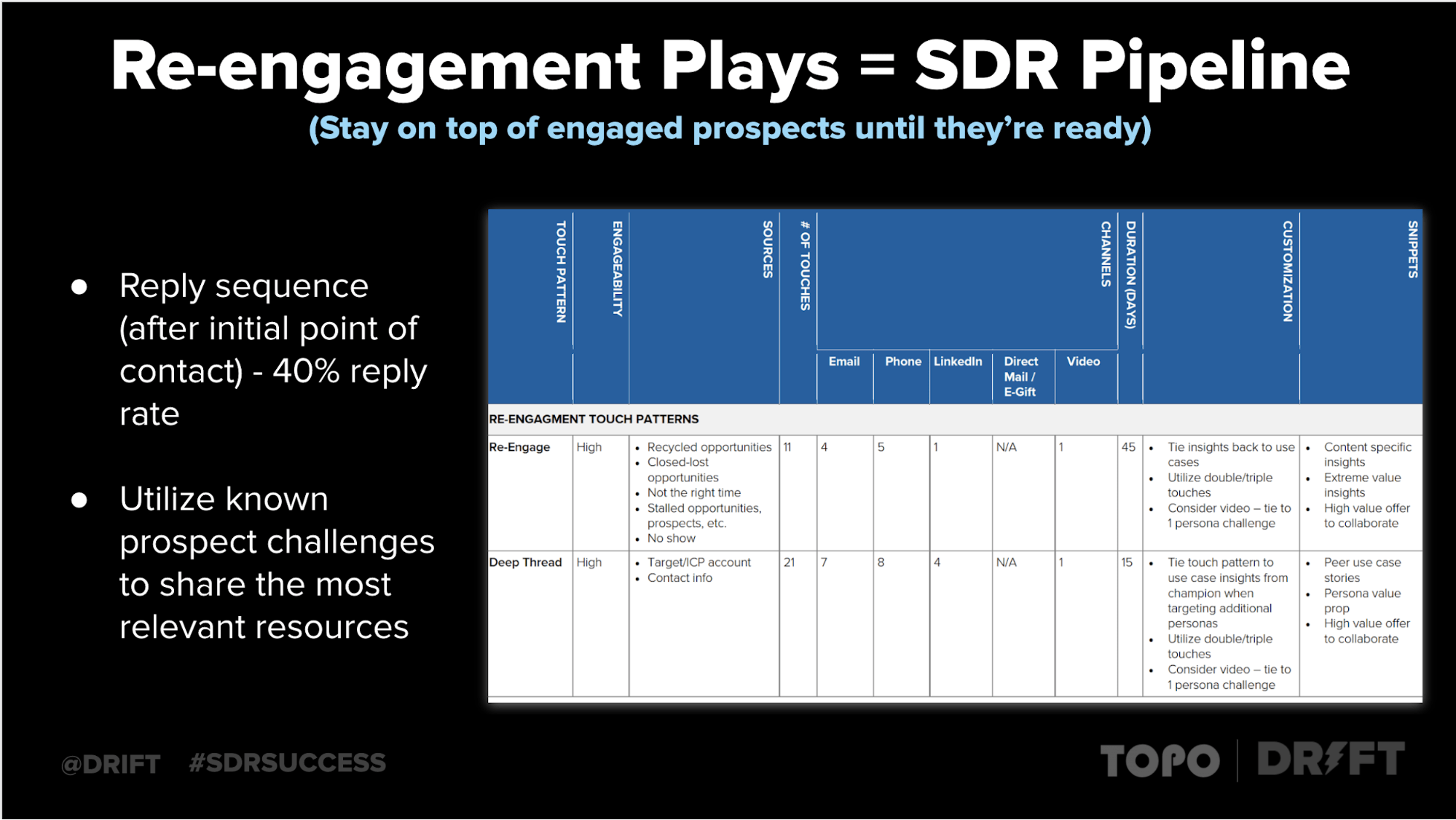
Drift’s inbound sequence has a 22% reply rate, which is great. Our reply follow-up sequence would be a 40% reply rate. So what that means is after you have that initial point of engagement, you are twice as likely to engage with them again. And that’s where you create that middle of the funnel pipeline.
When I think back to some of the most successful SDRs I’ve ever managed, the ones that did they best were the ones who could look at a pipeline of prospects and tell me what would be an opportunity in February, what would be an opportunity in March, and so on. And that way, they had their whole year planned out.
Metrics
Finding the right mix of metrics can be tricky. It’s your job as the SDR leader to step in, evaluate what’s going on, and determine the best way to go about it.
I’ll let you in on a little secret, is this funnel is going to be different for each one of your teams and also each one of the individuals on your team. And so a great way to get buy-in to a KPI, if you will, is for you to help your SDR understand how their funnel works.
It’s important to understand what your team’s funnel is so that you can do things like capacity planning in your financial plan. It’s also important to measure each rep individually so that you can coach them accordingly. This is why we recommend a two-pronged approach to narrow down the right metrics for your team.
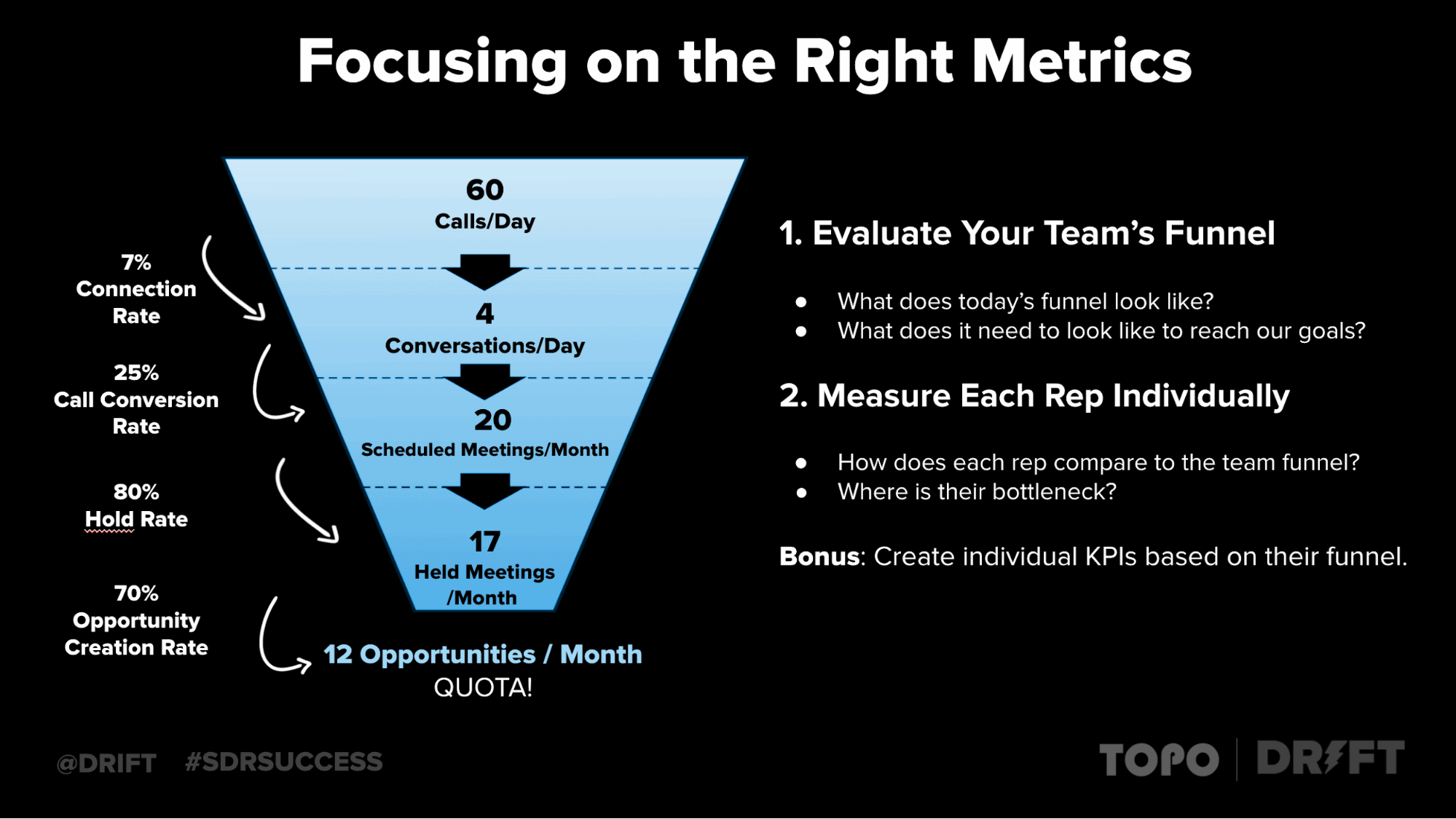
I used to live and die by this funnel, and I still find it extremely valuable in managing an SDR team. But what I’ve found is that the top piece of this funnel has actually changed. It’s not just about how many calls you make a day. It’s all about how do we get to those conversations – whether it be calls, email, chat, or social outreach.
Motivation
Here we have perhaps one of the most important parts of being an SDR leader. Figuring out what type of SDR you have will allow you to better understand what motivates their work. Some people love sales and will always be in those roles. Others use sales as a jumping-off point.
Dan says: “The business needs of sales development and the folks that are coming into the role have changed. No longer do we assume that the sales development reps only want a career in sales. We see organizations responding to the lifestyle and intellectual demands of SDRs to keep them in the role, keep them engaged, keep them motivated, and ultimately feed them into the rest of the business to further their career.”
Here, we breakdown the two types of SDRs you’ll typically see entering the sales field – learners and lifestylers:
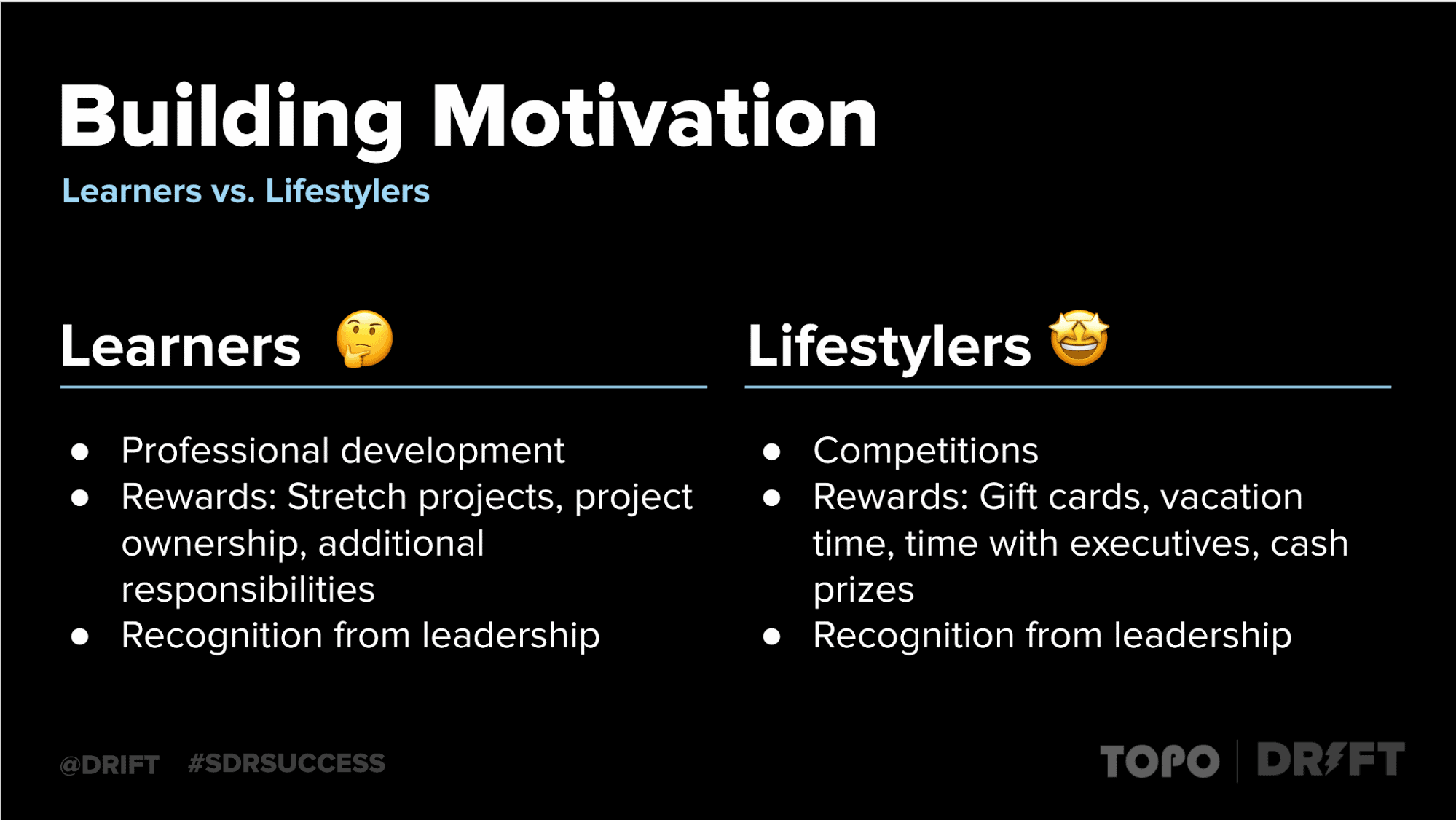
While some may see sales as an entry point into larger roles within an organization, those that view it as a lifestyle are still out there. Learning how to motivate both of these can be quite challenging.
What I like to do is give people stretch projects, both as a motivating factor for top performers and as the foundational piece for people that may need help in a certain area. When we talk about what it takes to become a strong SDR seller, we give projects to help develop certain skills they may be lacking to help them get there and treat it as a reward.
For example, let’s say you have an SDR struggling with their hold rate, or ratio between booked and held meetings. Here’s a thought – make them “hold rate captain.” Have that SDR post the team’s individual hold rates weekly, ask them to lead group discussions on how everyone can improve hold rate – and watch that specific SDR’s hold rate climb.
Giving stretch projects not only boosts SDR skills, but it also creates a camaraderie among colleagues and positively impacts the company’s bottom line.
Bringing It All Together to Drive Business & Quota
To recap, SDRs are one of the most valued roles within an organization. They lay the foundation for the company to be successful. Since a majority of the sales pipeline is generated through SDRs, they save time for AEs to focus on closing the deal. And more often than not, SDRs have the first interaction with your future customers.
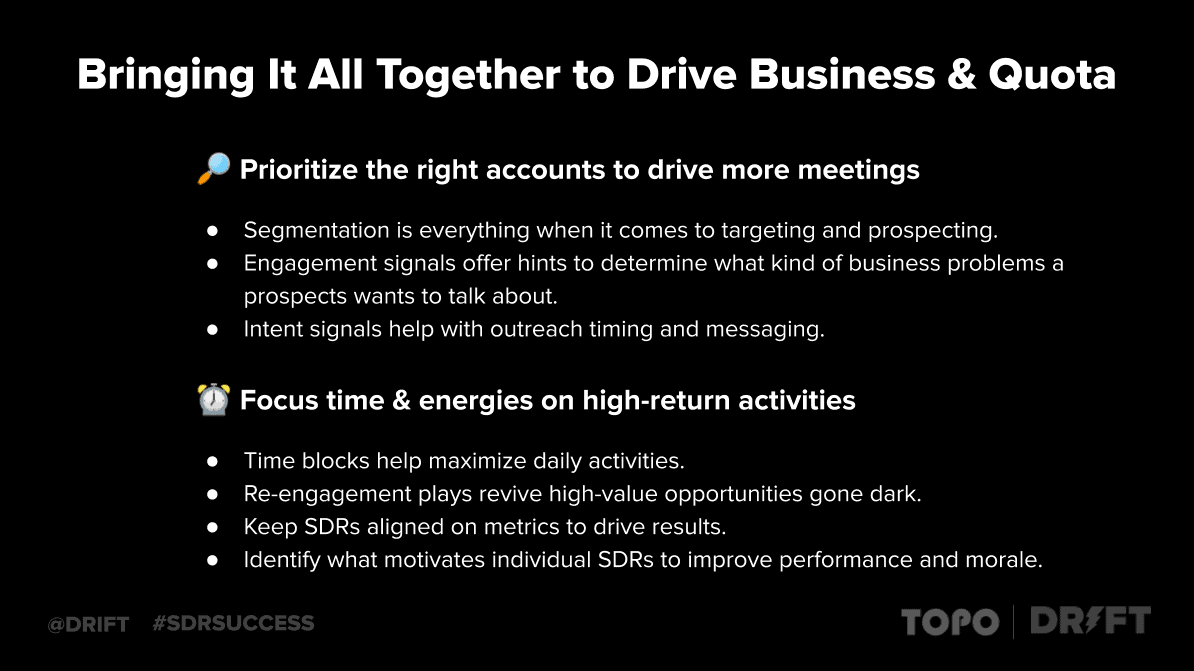
When leaders champion their SDRs through teaching time management, encouraging re-engagement along with finding the right metrics, and motivations, everyone wins.
Drift’s conversational ai can help you drive qualified pipeline for your sales team 24/7. Get a demo today.
Editor’s Note: This article was published in October 2020 and has been updated to reflect new information.





